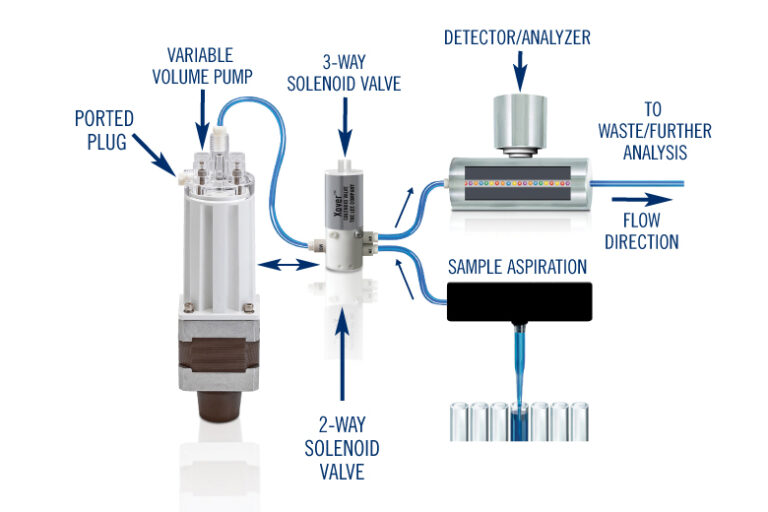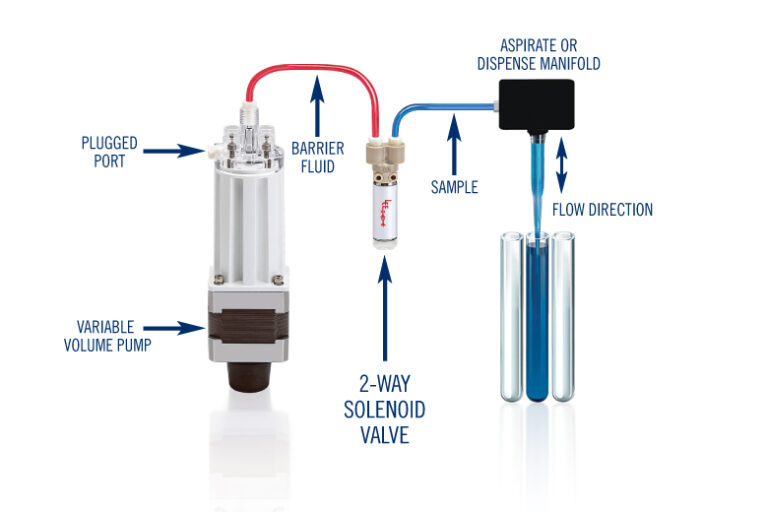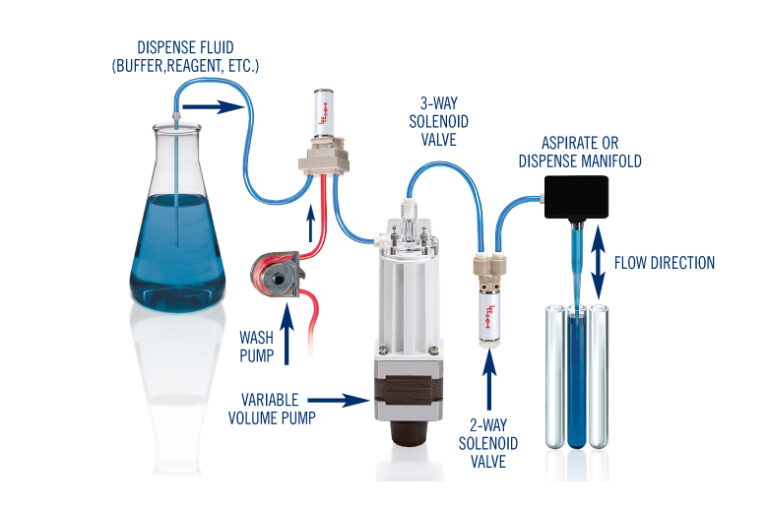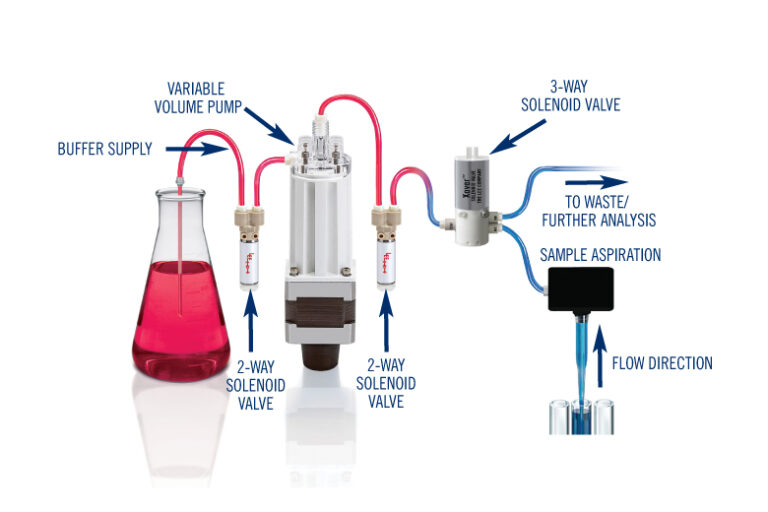Variable volume pumps, also known as precision dispense pumps, are a type of positive displacement pump that provide full dispense volumes ranging from 50 to 3000 µL. Variable Volume pumps require valves for proper operation. Common application schematics utilize 2-way solenoid valves, check valves, 3-way solenoid valves, or rotary valves. The following is an overview of common pump configurations used in a wide range of applications. Aside from these common setups, variable volume pumps can also be used in a variety of other ways, including as a single inlet valve with multiple outlet valves connected on a manifold, or as a mixture of check and solenoid valves. The Lee Company can integrate a variety of valve types as needed—simply contact us to discuss your application.
Let’s start with solenoid valves. These valves require attention to timing. While solenoid valves are generally fast acting, there is a delay in time between the command and valve actuation, known as the response time. If the variable volume pump’s piston begins to move before the valves have switched, the result can be a significant pressure spike (similar to dead heading). This can lead to problems with dispense accuracy and possibly physical damage to the valves or pump.
In this case, a 2-way isolation solenoid valve (such as the LFN or LFV Series diaphragm style valve), is placed at each port. Alternating the energized valve will allow the pump to aspirate fluid from the inlet, and then dispense through the outlet.

Check valves could also be utilized and do not require additional electronics. It is important to note that check valves can be susceptible to hysteresis and may result in lower accuracy or precision when dispensing. Contact The Lee Company for more information regarding check valve usage.
A single 3-way solenoid valve, such as the Xover® internal pinch-tube solenoid valve, can be used to simplify the fluidic schematic of the system. Since a single valve is being utilized, only one port is required. Typically, the side port of the port head is plugged or omitted for manifold-mount designs.

The greatest challenge to using a single 3-way valve is the “open over center” condition while switching the valve, which refers to the brief period during switching when all three ports are interconnected. If there is a pressure differential across any of these ports, it can result in fluid going in unintended directions, lowering accuracy and precision.
In some cases, a variable volume pump may be used with one valve or no valves. To operate a pump without valves, the port head is reduced to a single port by plugging one of the ports, and the piston extends and retracts to pipette the fluid. A single valve can be added to retain fluid in the system. This is particularly useful for moving samples between containers or dispensing buffer, wash, or trigger solutions to micro-titer plates.

A variable volume pump can function as a simple pipette if the system uses a tip to aspirate the fluid into tubing and then moves the tip to dispense into a reaction vessel or titer plate. If a valve is used, the volume within the tubing between the open end of the tip and the valve should be greater than the required dispense volume. The aspirated sample volume should be slightly more than the required dispense amount. Following the dispense of the sample, the tip can be placed over a waste station and additional fluid can be dispensed to ensure that all sample fluid and any sample mixed with the barrier fluid has been purged. If necessary, the tip can be placed in a vessel containing barrier fluid which can be aspirated to replace any fluid that was lost. This will keep the sample and/or barrier fluid from entering the valve or the pump.
Occasionally, there may be a requirement for flushing a system prior to an extended shutdown. While a system flush could be achieved using a variable volume pump, the volume of each cycle may be well below the system volume and require a time-consuming flush cycle. An alternative approach is to use a secondary flush pump, such as a solenoid pump or peristaltic pump, to quickly push a high volume of cleaning solution through the pump and system.
When the pump is used to aspirate and dispense different samples or fluids, a buffer or barrier fluid may be needed to prevent the sample from entering the pump. To accomplish this, a separate reservoir for buffer fluid can be connected to the inlet side of the pump. This will be used to make up any barrier fluid that was used to purge the left-over sample. The 3-way valve on the outlet side controls the aspirate, dispense, and purge of samples.

Partner with The Lee Company and get much more than just a supplier of top-quality fluid control products. Our reliable technical support team is available every step of the way to help you find solutions, maximize productivity, and drive efficiency across your operations. Check out these resources tailored to your industry to learn more.
LOOKING FOR LOCAL SUPPORT?
Our global sales force of technical sales engineers is available to provide fast, accurate customer assistance and help you find the best solution for your fluid control challenge
Always verify flow calculations by experiment.
*There are many parameters to consider when determining V-Factor. Click here for more information.
